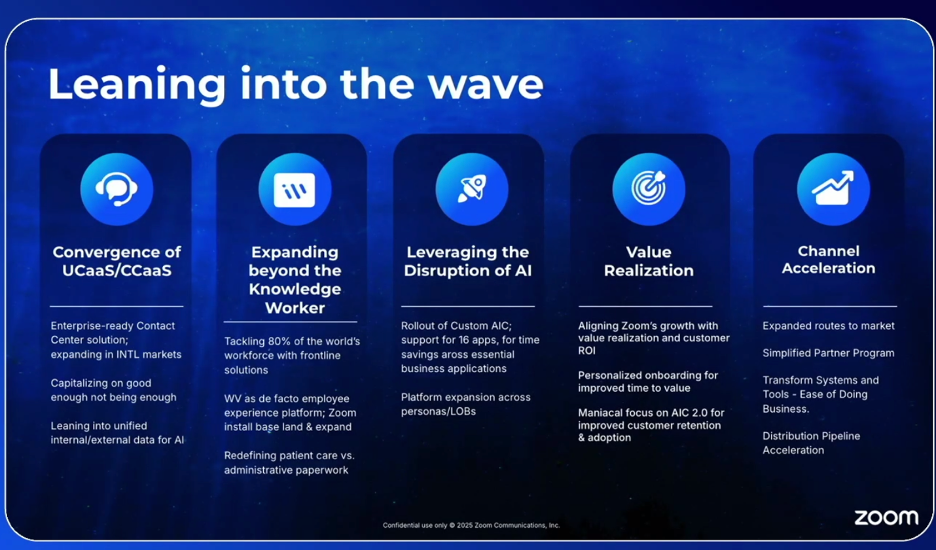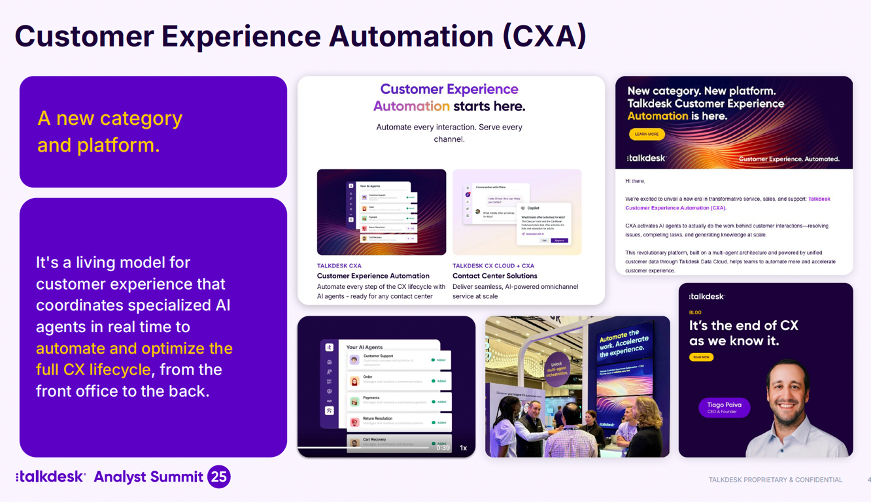Zoom Perspectives 2025 – From Conversations to Completion
- Blair Pleasant

- Jul 24
- 7 min read
Updated: Jul 25
Zoom held its annual analyst event in its hometown of San Jose, CA, providing insights into how the company is transforming from a collaboration company to a provider of an AI-first work platform. According to CEO Eric Yuan, Zoom’s goal is to provide an AI-first work platform that integrates applications into a single, natural language-driven interface, enhancing productivity and work effectiveness. The next step is digital assistants, and eventually true digital twins (don’t expect to see digital twins for another few years).
Analysts were introduced to the new CMO, Kim Storin, who noted that working at Zoom as CMO is a marketer's dream, as it's a brand that people know and love. Storin discussed how Zoom will position itself in the enterprise, SMB, and mid-market space, and that while Zoom serves the biggest enterprises in the world all the way down to very small businesses, “the middle will be our sweet spot,” adding that the middle section with 250-1000 employees “is where we have a right to put a stake in the ground.”
Riding the Wave – And a New GTM Approach
Graeme Geddes, Chief Sales Officer, discussed Zoom’s progress in the past year by providing a surfing analogy. He noted that surfers need to read the swell, and that companies can ride the wave – or be crushed by it. By reading the swell, Zoom identified three key areas of opportunity for Zoom:
· UCaaS + CCaaS convergence and unifying the way to serve internal and external stakeholders with a single platform
· Expanding beyond knowledge-based workers by transforming the way frontline workers connect and communicate
· The power of AI as a true companion
Geddes identified ways that Zoom is leaning into the wave, as shown in this slide.

Channel acceleration received a great deal of attention. One of the highlights of the event was hearing from new Head of Global Channel GTM, Nick Tidd. Tidd has been actively reshaping Zoom’s go-to-market strategy, driving meaningful transformation. As part of this evolution, Zoom is becoming increasingly channel-focused, aiming to significantly grow the contribution of channel-driven business. This shift is supported by a major expansion of Zoom’s partner ecosystem and increased enablement across the board. Tidd has radically transformed Zoom’s channel approach, with more to come.

Product Vision
Chief Product Officer, Smita Hashim, discussed Zoom’s product vision, which covers:
· Agentic experiences
· Meeting effectiveness
· Line of business and industry value
Hashim stated that Zoom’s goal is “Conversations to Completion,” turning conversations into actions, and then driving interactions to completion to help employees and customers, build stronger relationships.
Of course, agentic AI and Zoom AI Companion took center stage in the discussions. Zoom defines agentic AI as including reasoning, memory, orchestration, and task action.

Zoom’s agentic framework includes agents, skills, and models. Zoom offers several different types of agents, including Zoom Workplace Agents, Specialized Agents (such as the Zoom Revenue Accelerator), Custom Agents that customers can build on their own using Zoom’s AI Studio, and Third-Party Agents (such as the ServiceNow agent).
Some of AI Companion’s agentic skills include scheduling, task management, and deep research for data-driven decision making. Zoom utilizes various large language models, as well as its own small language models and third-party models, while enabling organizations to bring their own model.
In April Zoom launched Custom AI Companion, a paid add-on to customize the Zoom experience with advanced AI features, including meeting summary templates, third-party integrations, custom avatars, and more. Custom AI Companion helps customers tailor their AI solution to their organization’s goals and data. In addition to supporting enterprise customers, Zoom recently launched Custom AI Companion for SMB customers, focusing on core capabilities SMBs care about, including customized meeting summaries and additional third-party apps.
In this video interview, I spoke with Hashim about how customers are using Zoom’s UCaaS + CCaaS to get more power from the platform, what Zoom means by “Conversation to Completion”, and Zoom’s approach to agentic AI.
Zoom CX Making Tremendous Strides
Zoom has made tremendous progress with Zoom CX (ZCX, the renamed Zoom Contact Center), focusing on delivering positive experiences for employees and customers while driving strong business outcomes.
Chris Morrissey, GM & Global Head of Sales & GTM, discussed how Zoom is a connection-first platform, focused on creating experiences that make employees and customers feel connected and valued by the brands they choose. Zoom has seen a great deal of AI success for CX, including the AI Companion that comes with ZCX, as well as with AI Expert Assist, a paid option offering knowledgebase retrieval, information retrieval, auto disposition, agent guidance, smart notes, and more. Morrissey stated that Zoom is demonstrating innovation in AI transformation, noting, “We're not an AI-first company, we are a CX-first business, but we do use AI, and we have to demonstrate leadership there.”
During a session with Zoom channel partners, it became clear that partners are very bullish on ZCX. As one channel partner noted, “When Zoom rolled out Zoom Contact Center, we started positioning it as 80% of the capability at half the price, as it didn’t have all the robust features. But the pace of innovation has blown my mind. Zoom has reached par with all the CCaaS players, and it still offers disruptive pricing. Zoom can dominate this space and comes up in competitive conversations more than any other vendor.”
In this video interview, Morrissey discusses Zoom’s CX momentum, its key differentiation, and how Zoom is innovating in AI for CX.
To introduce many of its new capabilities, the CX team discussed the Five Pillars of Connected CX, and Zoom’s offerings and initiatives for these pillars.

For example, for Connected Journeys, Zoom introduced Advanced AI Routing, enabling callers to speak using natural language and get routed to the best-suited agent based on detected intent. Another capability for Connected Journeys is co-browsing with PII Masking to let agents securely co-browse with customers during chat and voice engagements.
For the second pillar, “AI built to resolve, not just respond,” Zoom announced Zoom Virtual Agent (ZVA) 2.0 - agentic AI voice and chat agents that reason, orchestrate, and execute actions with minimal human oversight. ZVA includes pre-built skills, such as schedule, search, summarize, respond, compose, etc. A demonstration of ZVA showed how easy it is to set up the virtual agent, define guardrails, set the virtual agent’s tone and appearance, configure the actions, retrieve data from a knowledge base or CRM, and more. With agentic capabilities, the virtual agent performs tasks using the prebuilt skills without specifically being instructed, based on its reasoning capabilities.
There were many new additions and enhancement for the Unified Customer Intelligence pillar. Zoom built a revamped CX Analytics platform to build journeys that are truly omnichannel, enabling customers to build dashboards and reports, and share them across the organization. The new analytics and reporting platform includes a new UI and GUI that is more intuitive and easier to use and lets customers build their own custom metrics.
The new Zoom CX Insights provides business insights from data from across the ZCX suite for use both inside and outside of the contact center. For example, it leverages AI to provide information on customer churn trends, product improvement opportunities, process bottlenecks, optimization priorities, and more.
There are two more pillars, and many more product announcements and enhancements, which can’t all be covered here.
To summarize and provide a good overview, Kentis Gopalla, head of CX Product and Ecosystem, discusses the five pillars of Connected CX and several of Zoom’s new CX announcements, including Zoom Virtual Voice Agent, Advanced QM, the new analytics platform, agentic AI, CX Insights, and more.
Zoom Workplace
Not to be overshadowed by Zoom CX, Zoom Workplace also had its share of enhancements and announcements. AI Companion has become supercharged with agentic capabilities for reasoning, memory, orchestration, and performing tasks.
With AI Companion, Zoom Workplace added agentic capabilities that help schedule meetings, auto-generate meeting agendas, takes live notes, capture action items and other tasks from recent communications. Other AI-enhanced capabilities include Zoom Power Dialer with built-in AI technology, and the ability for AI Companion to assist with Zoom Phone calls.
In this video interview, Theresa Larkin, Head of Zoom Workplace & AI Product Marketing, provides an update on what’s new in Zoom Workplace and AI Companion with agentic AI capabilities, as well as what’s next. She also discusses Zoom Phone and how it will leverage Zoom Virtual Agent for self-service.
Key Take-Aways
There was a great deal of information provided in 1 ½ days and it’s hard to summarize everything. Here are some of my key take-aways:
· Zoom remains extremely customer focused – Yuan truly cares about enabling customer happiness, which drives product innovation and development. Yuan set out to create a product that customers love and that’s easy to use, and this vision still fuels Zoom’s product development and innovation.
· Business outcomes are key, Zoom customers achieving notable results. For example, during the CX breakout, Amy Roberge, Head of Global Contact Center Solution Engineering, highlighted the business outcomes that various customers have attained, such as reducing call handle time from 15 minutes to 2 minutes, reducing after-call work to 30 seconds, saving $30k per year with native video, achieving 75% containment rate with ZVA, etc.
· While still serving large enterprises, Zoom is now focusing on the midmarket, which I believe is very sensible. Most competitors are targeting large enterprises, but there are many more mid-market organizations that need the products and capabilities that Zoom provides.
· UCaaS and CCaaS convergence is an important element of Zoom’s strategy and success, building upon each other and encouraging additional customer sales. For example, a large number of Zoom CX customers are adding Zoom Phone, while Zoom Workplace customers are adding Zoom CX.
· WorkVivo is an important differentiation for the company, which I expect to be leveraged increasingly going forward. Zoom discussed the pull-through opportunity from WorkVivo for the rest of the Zoom platform, noting several WorkVivo customers that moved to the Zoom platform. While the WorkVivo team didn’t present at the event this year (a missed opportunity), I spent time speaking with them and continue to be impressed with the value WorkVivo brings to Zoom and its customers.
· Zoom briefly talked about Value Realization and how the company helps customers get onboarded and enabled. I would have liked to have heard more about this, as this becomes increasingly important in an AI world. Zoom mentioned providing personalized onboarding for improved time to value, and how Zoom’s customer success teams help meet customers “where they’re at.” Customer adoption is critical, and Zoom is in a position to do more to help customers get the most out of their solutions.
· Integration into various third-party applications and workflows remain key, with a focus on helping developers and partners integrate various solutions. One channel partner noted, “Zoom makes it easy to work with other ecosystem partners so we can deliver robust solutions with Salesforce, ServiceNow, and others.”
It’s been clear for some time that Zoom is no longer just a video or meetings company. Even as the company expands into different areas, Zoom remains true to its core mission and philosophy – helping people connect, collaborate, and get more work done, while delivering happiness.


